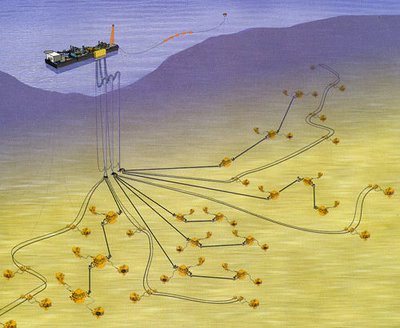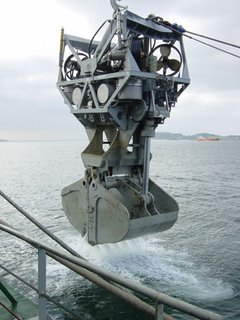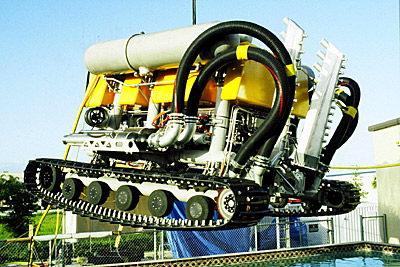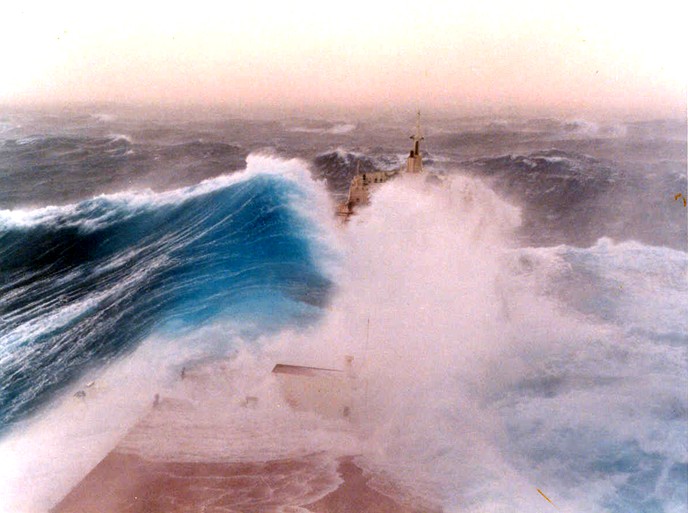
Layout of the Total Girassol field, off the shore of Angola in 1,400 meters of water, showing the FPSO ship, risers, flow lines, and subsea trees (well caps and valves on the sea floor).
Why peak oil is nonsense
There are any number of reasons why peak oil is nonsense, such as tar sands and coal gasification. Perhaps the most overlooked, however, is that up until now oil companies have focused on land and shallow seas, which are relatively easy to explore. But there is no reason to expect that oil, which was largely produced by oceans in the first place (especially by the precipitation of dead plankton), is any more scarce underneath our eon's oceans as it is under our lands. Oceans cover over two-thirds of our planet's surface, and most of that is deep water (defined in this series as ocean floor 1,000 meters or more below the surface). A very large fraction of the oil on our planet remains to be discovered in deep water. Given a reasonable property rights regime enforced by major developed world powers, this (along with the vast tar sands in Canada) means not only copious future oil, but that this oil can mostly come from politically stable areas.
The FPSO, riser towers and flow lines in Total's Girassol field off of Angola.
Some perspective, even some purely theoretical perspective, is in order. If we look at the problem at the scale of the solar system, we find that hydrocarbons are remarkably common -- Titan has clouds and lakes of ethane and methane, for example, and there are trillions of tonnes of hydrocarbons, at least, to be found on comets and in the atmospheres and moons of the gas giant planets. What is far more scarce in the solar system is free oxygen. If there will ever be a "peak" in the inputs to hydrocarbon combustion in the solar system it will be in free oxygen -- which as a natural occurence is extremely rare beyond Earth's atmosphere, and is rather expensive to make artificially. 
A deep sea "robot hand" on a ROV (Remotely Operated Vehicle) more often than not ends in an attachment specific for the job. Here, a subsea hydraulic grinder and a wire brush.
What's even more scarce, however, are habitable planets that keep a proper balance between greenhouse gases and sunlight. Venus had a runaway greenhouse, partly from being closer to the sun and partly because of increased carbon dioxide in its atmosphere which acts like an inulating blanket, preventing heat from radiating away quickly enough. The result is that Venus' surface temperature is over 400 C (that's over 750 fahrenheit), hotter than the surface of Mercury. On Mars most of its atmosphere escaped, due to its low gravity, and its water, and eventually even much of its remaining carbon dioxide, froze, again partly due the greater distance from the sun and partly due the low level of greenhouse gases in its generally thin atmosphere.
Hydraulic subsea bandsaw. Great for cutting pipes as shown here.
So far, the Earth has been "just right", but the currently rapidly rising amount of carbon dioxide and methane in our atmosphere, largely from the hydrocarbons industries, is moving our planet in the direction of Venus. Nothing as extreme as Venus is in our foreseeable future, but neither will becoming even a little bit more like Venus be very pleasant for most of us. The real barrier to maintaining our hydrocarbon-powered economy is thus not "peak oil", but emissions of carbon dioxide and methane with the resulting global warming. That peak oil is nonsense makes global warming even more important problem to solve, at least in the long term. We won't avoid it by oil naturally becoming too expensive; instead we must realize that our atmosphere is a scarce resource and make property out of it, as we did with "acid rain."
This series isn't mainly about oil or the atmosphere, however; it is about the technology (and perhaps some of the politics and law) about extracting minerals generally from the deep sea. Oil is the first deep sea mineral to be extracted from the sea on a large scale. The rest of this article fill look at some of the technology used to recover offshore oil, especially in deep water. Future posts in this series will look at mining other minerals off the ocean floor.
Painting of the deepwater (1,350 meters) subsea trees at the Total Girassol field. They're not really this close together.
FPSOs
Once the wells have been dug, the main piece of surface equipment that remains on the scene, especially in deep water fields where pipelines to the seashore are not effective, is the Floating Production, Storage, and Offloading (FPSO) platform. The FPSO is usually an oil tanker that has been retrofitted with special equipment, which often injects water into wells, pumps the resulting oil from the sea floor, performs some processing on the oil (such as removing seawater and gases that have come out with the oil), stores it, and then offloads it to oil tankers, which ship it to market for refining into gasoline and other products. The FPSO substitutes far from shore and in deep water for pipes going directly to shore (the preferred technique for shallows wells close to a politically friendly shoreline).
Many billions of dollars typically are invested in developing a single deep water oil field, with hundreds of millions spent on the FPSO alone. According to Wikipedia, the world's largest FPSO is operated by Exxon Mobil near Total's deep water field off Angola: "The world's largest FPSO is the Kizomba A, with a storage capacity of 2.2 million barrels. Built at a cost of over US$800 million by Hyundai Heavy Industries in Ulsan, Korea, it is operated by Esso Exploration Angola (ExxonMobil). Located in 1200 meters (3,940 ft) of water at Deepwater block 15,200 statute miles (320 km) offshore in the Atlantic Ocean from Angola, West Africa, it weighs 81,000 tonnes and is 285 meters long, 63 meters wide, and 32 meters high ((935 ft by 207 ft by 105 ft)."
ROVs
Today's ROVs (Remotely Operated Vehicles) go far beyond the little treasure-recovery sub you may have seen in "Titanic." There are ROVs for exploration, rescue, and a wide variety of other undersea activities. Most interesting are the wide variety of ROVs used for excavation -- for dredging channels, for trenching, laying, and burying pipe, and for maintaining the growing variety of undersea equipment. Due to ocean-crossing cables and deep sea oil fields, it is now common for ROVs to conduct their work in thousands of meters of water, far beyond the practical range of divers.
A grab excavator ROV.
It should be noted that in contrast to space vehciles, where teleprogramming via general commands is the norm, and often involves long time delays between the commands being sent and the results being known to the spacecraft's operators, with undersea operations real-time interaction is the norm. Due to operator fatigue and the costs of maintaining workers on offshore platforms, research is being done on fully automating certain undersea tasks, but the current state of the art remains a human closely in the loop. The costs of maintaining workers on platforms is vastly lower than the cost of maintaining an astronaut in space, so the problem of fully automating undersea operations is correspondingly less important. Nevertheless, many important automation problems, such as the simplification of operations, have had to be solved in order to make it possible for ROVs to replace divers at all.
A ROV for digging trenches, used when laying undersea cable or pipe.
Another important consideration is that ROVs depend on their tethers to deliver not only instructions but power. An untethered robot lacks power to perform many required operations, especially excavation. At sea as long as the tether is delivering power it might as well deliver real-time interactive instructions and sensor data, i.e. teleoperation as well.
Trenching and other high-power ROVs are usually referred to as "work class." There are over 400 collectively worth more than $1.5 billion in operation today and their numbers are increasingly rapidly.
Tankers are big, but storms can be bigger.
Harsh Conditions
Besides deep water and the peril of storms anywhere at sea, many offshore fields operate under other kinds of harsh conditions. The White Rose and Sea Rose fields of Newfoundland start by excavating "glory holes" dug down into the sea floor to protect the seafloor against icebergs which can project all the way to the fairly shallow sea floor. Inside these holes the oil outflow and fluid injection holes themselves are dug and capped with subsea trees (valves). The drill platform, FPSO, and some of the other equipment has been reinforced to protect against icebergs.In future installments, I'll look at diamond mining and the startups that plan to mine the oceans for copper, gold, and other minerals.

6 comments:
Good article. Looking forward to the rest of the series. And compliments on the blog overall.
Great article, I think however, you are misunderstanding the theory of peak oil. Peak oil states that any given oil field will eventually peak out and decline in production. The problem is that as the cheap producing fields (Gawar in Saudi Arabia for example) that were literally oozing to the surface naturally are spent, oil becomes more expensive to produce. I think even you would agree that producing from the deep sea fields will be much more expensive than producing from the fields in West Texas was! And on top of it, West Texas Intermediate is an easily refined liquid while most deep sea oil is heavy and more difficult to work with (like tar sands and oil shale, only those aren't even technically oil but rather an oil precursor). It's not that one day we'll run out of all oil and be living in the stone age, it's simply that oil is climbing in price and until these fields are brought online and consumption has dropped precipitously, it won't come down in price! That's why it's new trading floor is $60 rather than the historical price of less than $10 a barrel pre US peak.
As greg said. Peak oil does not mean that we run out of oil. It means that volume of oil production peaks. This happens long before we have used even half of the oil in the ground.
Important consept you are missing is EROI, Energy return on investment. It is the ratio of the energy extracted or delivered by a process to the energy used directly and indirectly in that process.
In the 1930s, US oil was easy to recover. In many cases it was almost at the surface and had an EROI of 100:1. As it gets deeper, harder to find, more viscous, higher sulfur content, etc, the EROI will continue to decline. Today, the average world EROI is something like 5-10:1 after refining (you spend one barrel of oil to get 5-10 barrels).
It takes about 735 joules of energy to lift 15 kg of oil 5 meters out of the ground just to overcome gravity - the energy is required to lift oil from 27,000 feet beneath the ocean (Jack II), is huge. Soon after that point it makes no sense to drill/extract any more resource because it takes as much energy to do so as you get out. The resource has become a sink. In practice, when we reach 3:1 returns, it becomes economically non practical to extract oil (when oil prices go north fo $120-$150 barrel we have a crisis).
greg: "Peak oil states that any given oil field will eventually peak out and decline in production."
But this trivial truth is not, of course, what most people mean by "peak oil". For most people, "peak oil" is a supposed imminent crisis in which we run out of liquid hydrocarbons as an economical source of energy.
anonymous thoroughly confuses price with EROI. They often don't have much to do with each other. Price is primarily driven by the general commodity inflation, which in turn is primarily driven by central bank policy. The gold/oil price ratio is still near 10:1 (gold per troy ounce over oil per barrel). That ratio is still well within the range that it has been for most of the last century. Oil could be $100 per barrel or $1,000 per barrel and still say nothing about EROI.
Alas, inflation first shows up in commodities (as the most easily traded inflation-proof asset) and gives the false signal to all the "peak oil" fanatics that we are "running out of oil." The same thing happened in the 1970s, when there was no more or less "oil shortage" than there was in 1991 or now.
As for EROI, all the major EROI barriers are amenable to technological improvements. Only a modicum of mechanical literacy, for example, is needed to see that what anonymous suggests is a supposedly hard physics barrier of gravity is no such thing. Look at how an elevator works -- counterweights. Elevator engineers have long ago overcome anonymous' fear and do not need to expend in the net as much energy as would be required to lift all the people they lift, because they can take people and things down too. Similarly, water or sludge could be dropped to replace oil if the gravity barrier ever actually became an EROI barrier to oil extraction.
Innovations have substantially reduced the EROI of tar sand extraction over just the last two decades, putting the vast supplies of tar sands (which probably far exceed Middle Eastern supplies of oil) at our disposal. And we long ago learned how to gasify coal with a good EROI. Despite several hundred years of intensive coal use we are nowhere near "peak coal."
The "peak oil" movement is full of people obsessing over a handful of simple variables, thinking that by themselves these variables reflect the full reality, and incapable of looking at the broader picture so that they can interpret those variables in context. It's also full of people who can't seem to find any meaning unlife unless they can get all jacked up about some looming disaster.
FPSO are the nice develop of tanker, the most smart use for the old tanker which found a new way to be used.
by the way is also true a lot of company have "see" the bussiness and built specific fpso like first installation
Logistic department bassioffshore.com
[url]www.bassioffshore.com[/url]
The vane type and the hot wire type are the two types of AFMs. The first one contains a flap that is forced by the incoming air. More flaps are forced back when there is more amount of air that is coming in. A potentiometer that is attached to the flap sends a signal of voltage to the Power train Control Module (PCM). Behind the main vane is a second vane. This fits into a closed camber which suppresses the movement of the vane. In effect, a more accurate measurement is given. An Air Temperature Sensor, which functions exactly as it does in the carbureted engine, is also built into the vane AFM.
Flowmeter Depot
Post a Comment